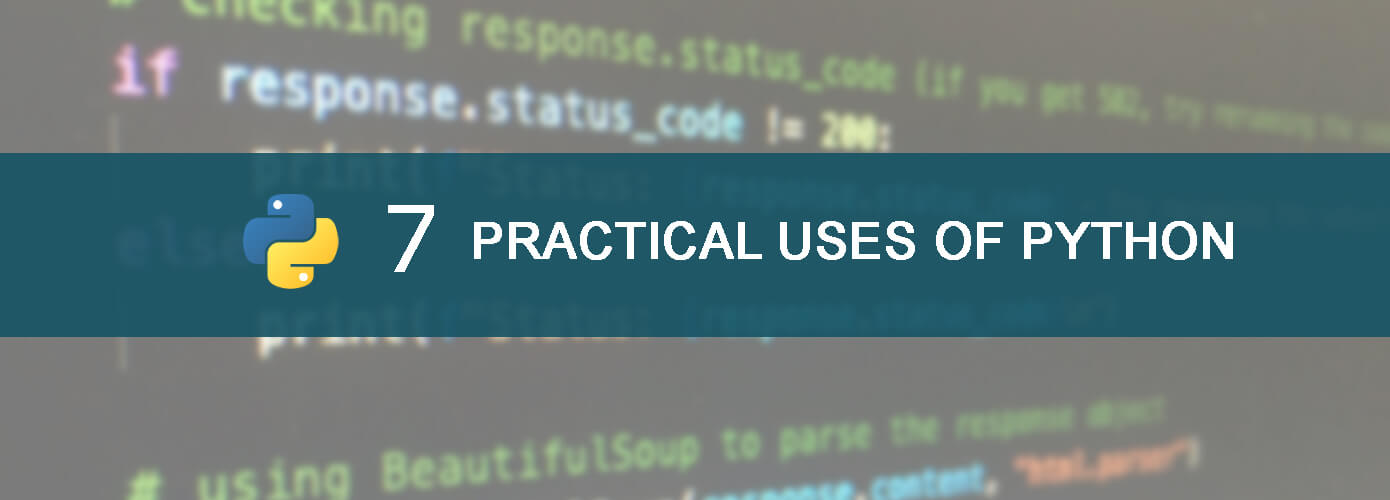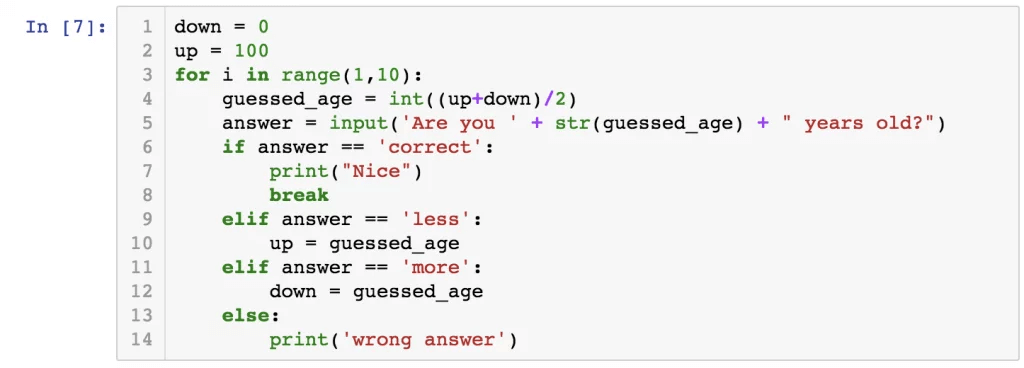What is Python used for? Exploring 7 practical Python uses

According to Forbes, Python is a tool for anyone to write a script easily and fast. The language is called easy to learn, handy to read and write, and extremely flexible. Is this language really so cool and versatile? Let’s consider some examples of where is Python used and how it can help industries.
First question: what is Python?
Python.org defines it as an interpreted, object-oriented, high-level programming language with dynamic semantics. It was created in 1991 by Guido Van Rossum, a Dutch programmer who wanted the language to be intuitively understandable.
Python is a general-purpose programming language that isn’t focused on specific areas but can be used to create various programs and applications. Python is a popular programming language for its versatility and its claimed beginner-friendliness. Unlike other popular languages like JavaScript, Python features a simple syntax similar to English that is easier to understand and learn.
Understanding the basics of Python
What’s so special about Python that makes it so popular? We’ll mention some of the language’s peculiarities.
High-level language
Being high-level means being easier for humans to read, write, and understand. Python allows developers to abstract away from hardware issues like memory management and focus on facing software challenges.
Open source
Python’s source code is publicly available for free and can be modified by the contributors. This results in continuous improvement of the language and its adoption by more developers.
Higher readability
One of Python’s main features is its simple and understandable syntax: Python code can even look like pseudo code at first glance. The clean syntax makes the code easier for both junior and senior developers to collaborate.
General-purpose
Python can be used for pretty much any industry and domain, to create a wide range of applications. Web development, software development, data analysis and engineering, machine learning are just several mentions of what is Python good for.
Numerous frameworks and libraries
Python has an extensive set of additional tools for developing various applications. For instance, Django and Flask are widely used for web development, Pandas and NumPy are applied for data analysis, TensorFlow and Scikit-learn help in machine learning projects.
Large community
Python is known for its active and friendly community of contributors: there’s documentation and plenty of tutorials available. In addition, developers can find answers on forums. Knowledge sharing contributes to better software solutions within projects.
Researching Python’s simple syntax
Python’s philosophy emphasizes “readability” as a crucial factor. It strives to minimize blocks of source code text and prefers white space, resulting in a clearer and less cluttered appearance. Unlike many other programming languages that use braces {} or keywords to delimit blocks of code, Python uses indentation to indicate blocks. This way Python simplified its syntax making the overall code structure and view more readable and neat.

So, what is Python language used for?
What can you do with Python? Let’s consider some examples of practical uses for Python.
1. Using Python in web development
What is Python mainly used for within web development? It’s creating the back end: a part of a website or web app that handles sending data to and from servers. Python offers various frameworks for web development, with popular choices including Django and Flask. These frameworks come with specialized built-in modules for data sharing, information processing, database access, URL routing, content management, and website security.
Frameworks used in web development
Django: A high-level framework that encourages rapid development and clean, pragmatic design. It’s known for its robustness and the ability to handle complex applications.
Flask: A micro-framework that offers simplicity and flexibility. It’s lightweight and ideal for small to medium-sized applications.
Pyramid: Designed for both small and large applications, providing much flexibility.
Bottle: Another micro-framework that’s very simple and perfect for building small web applications.
Examples
Google, Facebook, Instagram, YouTube, Dropbox, and Reddit use Python in their products.
2. Software development
Let’s consider Python uses throughout all stages of the software development process, from build control and automated continuous compilation to prototyping, bug tracking, testing, and software maintenance. Its flexibility and power make it suitable for creating both simple and highly advanced applications, making it a versatile choice for various development needs.
Frameworks used for desktop application development
PyQt: a set of Python bindings for the Qt framework. PyQt includes classes for building GUI applications.
Tkinter: a standard Python interface that allows building GUI applications without the need for third-party dependencies.
Kivy: a library for developing applications featuring cutting-edge UI, including multi-touch applications.
Examples
Blender: An open-source 3D modeling and animation software that uses Python for scripting and automation.
Dropbox: Initially used Python for its desktop client.
GIMP: Python along with other languages is used for creating plugins and scripts to extend GIMP’s functionality.
3. Scripting and automation
Python is a wonderful tool for automating repetitive tasks, also known as scripting. Such automation helps pass on mundane tasks to a program instead of doing everything manually. For instance, Python is great at file and folder management. A script written in Python can create or rename files, convert them into another format, check them for errors, modify and update file content, detect duplicates, split or merge files, and more. This can be helpful for business applications that increase productivity and mitigate problems of manual data processing.
Libraries used for scripting
Selenium: allows developers to write scripts that can interact with web pages as a human user would: click buttons, fill out forms, and navigate through pages.
BeautifulSoup: a library for pulling data out of HTML and XML files.
Requests: a lib for making HTTP requests, predominantly designed for web applications.
Examples
Web scraping scripts: automate data extraction from websites.
Task automation scripts: Automate repetitive tasks in system administration.
4. Network programming
Python is used for both low-level and high-level network access. Python provides a built-in module called socket which allows for low-level network communication. This is useful for creating both clients and servers that communicate over TCP/IP or UDP. The high-level access allows for the implementation of HTTP, FTP, and other protocols. Flask and Django are popular web frameworks that simplify creating RESTful APIs for network applications.
Libraries
Twisted: an event-driven networking engine suitable for building high-performance servers and clients.
asyncio: supports asynchronous network operations, which is useful for handling many connections simultaneously.
Examples
BitTorrent: Uses Python for peer-to-peer file-sharing protocols.
Paramiko: A library for making SSH2 connections (client and server).
5. Educational tools & platforms
Python can be used to create interactive learning platforms, automated grading systems, learning management systems, tutoring systems, and chatbots. Let’s consider some examples of how is Python used for educational purposes.
Tools
Pygame: a cross-platform set of Python modules used to create educational video games that make learning fun and interactive.
Django, Flask: used to build comprehensive learning management systems.
NLTK, spaCy: Python libraries used to generate educational content, quizzes, and assessments automatically.
Examples
Project Jupyter is aimed at developing open-source software, open standards, and services for interactive computing across multiple programming languages. Jupyter Notebook is a type of Integrated Development Environment that is widely used in education for creating interactive and executable documents that combine code, text, and visualizations.
Platforms like Coursera and edX use Jupyter Notebooks for their coding assignments.
AutoGrader: a Python-based tool that evaluates students’ code against predefined test cases.
Moss (Measure of Software Similarity): a tool used to detect plagiarism in coding assignments.

6. Data analysis and visualization
In today’s industries, data holds immense value, and businesses are keen on collecting, processing, and analyzing it to derive crucial insights. Here Python comes into play due to its extensive standard library and a rich array of specialized modules tailored for analytical tasks. For instance, it helps data analysts to make sense of complicated data sets and make them easier to understand. Data visualization is another essential component of data analysis as it allows for presenting information more engagingly and insightfully.
Libraries
Pandas: used for analyzing, cleaning, exploring, and manipulating data.
NumPy: used for working with arrays.
Matplotlib: used for creating high-quality visualizations and graphs.
Seaborn: used for making statistical graphics.
Examples
Performance dashboards: Visualize student progress and identify areas where they need help.
Predictive analytics: Predict student outcomes and identify at-risk students.
7. SEO
Automation plays a significant role in SEO, and Python offers excellent support in this area. Whether it’s making changes across multiple pages or organizing keywords, Python proves to be a valuable asset. Python is brilliant at natural language processing technology so it can help understand how people form their search inquiries and how search engines return results.
Libraries
Pandas, NumPy: used to analyze and visualize ranking data from search engines.
NLTK, SpaCy: natural language processing libs to analyze and optimize website content for better relevance and keyword usage.
Industries that use Python
Let’s briefly review ways in which Python helps various industries.
Software and web development: building desktop and web applications, developing back end, automating system administration tasks with Python scripts
Fintech: building financial models, analyzing financial data and algorithmic trading, detecting fraud
Healthcare: researching medical data, genome sequencing, drug discovery, patient data management
Education: developing educational and learning management systems, conducting academic research
Retail and e-commerce: developing recommendation engines for personalized shopping, analyzing sales data and customer behavior
Media and entertainment: developing content management systems and automating workflows, developing games
Manufacturing and supply chain management: automating manufacturing processes, analyzing data for predictive maintenance of equipment
Marketing and advertising: analyzing marketing campaigns, targeting, and web traffic data, automating SEO tasks
Why should you use Python?
We often hear questions like why use Python? However, it’s not quite correct: it’s not about some languages being better than others, so we must use them. It’s about when to use Python, based on what can Python do for your project. The technology should be chosen only after the project goal is clearly defined. But let’s abstract away a bit and consider Python’s strengths and why developers love to use it.
Python’s advantages
Developers love Python because it’s open-source, has an accessible learning curve, and is highly readable. Some additional benefits of using Python include:
Cross-platform compatibility on various operating systems such as Windows, Mac, Linux, and Raspberry Pi
Simple syntax, similar to basic English, makes it easier to learn and use
Python’s open-source nature and support of the strong online community
A vast number of libraries extending Python’s functionality
Efficient coding, allowing engineers to type less and do more
An interpreted language, meaning that code is implemented line by line
Dynamically typed construct, where variables and data types need not be explicitly declared
Versatility that allows developers to use Python for diverse projects without needing to switch to other languages
Differences between Python and other programming languages
Syntax and readability
Python uses indentation to define code blocks, which enforces a uniform code structure. In contrast, commonly used programming languages like C++, Java, and C# use braces {} to define code blocks and require semicolons ; to terminate statements, making the code appear more cluttered.
Ease of learning
Python is often considered one of the easiest programming languages to learn, especially for beginners, due to its straightforward syntax and comprehensive standard library. On the other hand, languages like C++ and Java have steeper learning curves due to more complex syntax and concepts.
Performance
Python’s interpreted nature and dynamic typing generally lead to slower execution compared to compiled languages like C++. However, performance can be improved with optimization techniques and libraries like NumPy for numerical computations. In contrast, languages like C++ are known for high performance and are often used in system-level programming, game development, and applications requiring intensive computation.
Standard library and ecosystem
Python offers a vast and comprehensive standard library supporting common programming tasks, along with thousands of third-party packages on the Python Package Index (PyPI). While languages like Java also have extensive libraries and a robust ecosystem, the range and ease of using Python’s libraries are often seen as more user-friendly and diverse.
Use cases
Python is widely used for web development (Django, Flask), data science tasks (Pandas, NumPy, Scikit-learn), machine learning (TensorFlow, PyTorch), automation, and scripting. Java is preferred for enterprise applications, Android app development, and large systems requiring robustness and scalability, while C++ is used in system and software development, game development, and applications requiring high performance. JavaScript is dominant in web development for both front-end (with frameworks like React and Angular) and back-end (Node.js) development.
Development speed
Python enables rapid development and prototyping due to its simplicity and readability, making it ideal for startups and projects with tight deadlines. Development in languages like C++ and Java can be slower due to more complex syntax and longer compilation times.
Frequently Asked Questions
What are the key features that make Python a versatile programming language?
Python’s clean and readable syntax and comprehensive standard library make it easy to learn and efficient for numerous applications. Its dynamic typing and interpreted nature enable rapid development and flexibility, making it suitable for everything from web development to data science and automation.
Is it hard to learn Python?
Python is generally considered easy to learn due to its simple and readable syntax, which is designed to be intuitive for beginners. Its extensive documentation and supportive community further facilitate the learning process, making it accessible even for those new to programming.
What libraries and frameworks does Python offer?
Python offers multiple libraries and frameworks, including Django and Flask for web development, Pandas and NumPy for data analysis, and TensorFlow and PyTorch for machine learning. Libraries like BeautifulSoup and Scrapy facilitate web scraping, while Matplotlib and Seaborn are used for creating data visualizations.




